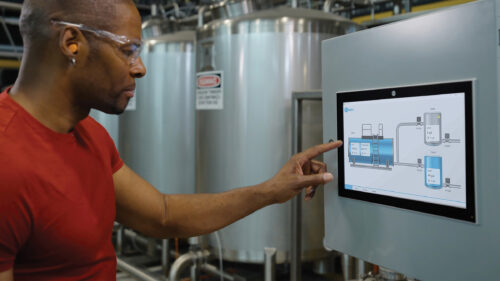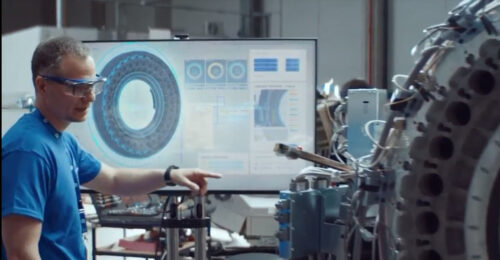Scalable and modular HMI options support many industry applications
Flexible human-machine interface (HMI) solutions maintain the advanced functionality of modern hardware while adapting to the needs of each application.
Modern human-machine interface (HMI) hardware should make equipment operation on the plant floor more efficient and intuitive. However, if machine builders or users select components that do not fit the industry or application, it can increase frustration. Selecting HMI hardware tailored to application needs is essential and can lead to significant cost savings, upfront and down the road. Some industrial vendors offer custom HMI hardware that adapts to every industry’s unique operator interface (OI) challenges through application-specific design, customization options and user-friendly functionality.
The HMI’s physical design and installation is critical to ensure the hardware’s longevity and the integrity of the automated system. Some vendors only offer HMI products that are cabinet-mountable, or they offer products built with less durable plastic materials. This leads to shorter product lifespans and more frequent repair or replacement. Plastic housings can work in some situations, but most industrial settings call for durable HMI with enclosures made of aluminum or steel.
Many options are available for machines with few plant environment considerations. However, engineers in the food, pharmaceutical and process industries need to look for additional features, such as stainless steel HMI housings.
Food, pharmaceuticals, other sanitary manufacturing
For industries like food production and pharmaceuticals, selecting a plastic HMI can affect product quality and safety. For cabinet-mounted panels, the protection rating should be IP65 (IEC standard 60529 International Protection Marking) on the front side to accommodate operation and typical cleaning procedures in environments with airborne moisture and particles. The HMI’s backside can suffice with an IP20 rating if it’s protected inside a cabinet. For advanced enclosures, panels can be lined with an FDA-approved blue silicon seal. The blue color makes it easy to visually detect food particle and bacteria build up. The blue silicon seals are helpful in food production and other applications with strict hygienic requirements.
Industrial displays that can be installed on a mounting arm outside of the cabinet must at least be rated IP65 on all sides. These panels should be capable of functioning in high-moisture environments. A stainless steel HMI is used widely in these cases. The cabinet- and arm-mountable HMI also should possess zero flat edges on all exposed sides to make it difficult for bacteria to accumulate on the surface.
Proactive HMI selection, process safety
Options for explosion-proof HMI hardware provide the necessary safety level for hazardous environments without sacrificing the functionality that newer models offer. Control panels and panel PCs that are IECEx certified for use in Zone 2/22 are key for applications with potentially combustible conditions. These panels are critical for facilities that process oil, chemicals, gases, alcohol, flour, sawdust and other flammable products.
In areas with demanding safety restrictions, HMIs must have appropriate designs and retain high levels of functionality. HMI devices constructed using one piece of milled aluminum improve the hardware integrity and support safe use in hazardous environments. A zone 2-rated HMI is available in various sizes with multi-touch technology as well as one-cable technology (OCT) to provide USB 2.0 signal (DVI signal and power via one cable) to support efficient, space-saving installation. With OCT solutions, control panels are operable at distances up to 100 m from the machine controller, which could be useful for challenging process applications.
HMI customization, finishing touches
Today’s HMI has many customizable elements, which provide design options ranging from slight modifications of vendors’ standard product to revamped custom housings that look like a direct extension of the overall machine design. Customization can start with a simple addition like a company logo and extend to unique housing layouts provided by a high-volume machine builder.
Engineers should work with vendors that provide a broad range of display sizes to ensure they can find the ideal fit and price point. Modern features such as multi-touch and widescreen are popular selections for machine builders and manufacturers today. More traditional single-touch and 4:3/5:4 ratio displays still are used and offered by some vendors. Economy line displays are great for small machines and building automation applications. Even with older screen orientations and entry-level price points, it still is possible to find affordable panels that forego plastic housings for higher-quality metal housings.
HMIs should always be flexible and responsive to meet the specific industry’s demands. It is important HMIs offer the option to create custom button layouts to perform application-specific commands. Even with multi-touch displays, it is still beneficial to have additional mechanical push buttons to complete specific actions. The most popular pushbutton is the classic red e-stop, but there are plenty to choose from, including switches, keys, joysticks, radio frequency identification (RFID) scanners and handwheels. There also are industry-specific button layouts that conform to common machine types found in packaging, computer numerical control (CNC) and metalworking and plastics, among others, to give engineers in any field a good starting point.
In addition to passive control panels, today’s panel PCs offer machine control with high-performance and low-power processors. Panel PCs also are available in similar form factors as control panels, but they also leverage today’s automation software for all-in-one HMI and control capabilities.
HMI software, varied hardware
HMIs should support user-friendly functionality for plant operations. HMI hardware that also runs core application software can eliminate communication issues between hardware and software. HMI software that is web-based and accommodates display on mobile devices and push notifications can help simplify plant operations.
Programming for HMI and control in the same software is possible with a PC-based automation platform, especially those built into an integrated development environment (IDE). An IDE streamlines the programming process by using simple graphic editors that allow programmers to link commands and controls to real-time variables. Certain software libraries come with pre-defined templates, which permit quick and painless application startups. HMI projects that can be applied in Oracle JavaScript or as a server extension allow engineers to create extensions in high-level languages.
An HMI that adapts to the various devices at an engineer’s disposal helps keep track of operations from anywhere. Whether it is a smartphone, tablet, or industrial panel, some software automatically can adapt according to screen size, resolution and orientation of each device.
HMI integration with cloud services simplifies secure and organized data communication with the cloud. Some vendors have integrated popular voice-enabled functionality into automation software using text-to-speech applications for situations where hands-free operation is preferable.
All of these features are available for the purpose of making the HMI useful and adaptable to the end user. Vendors that offer targeted HMI options for all control architectures—including local client, multi-client, multi-runtime, multi-server and multi-protocol—enable engineers to use a diverse hardware and software ecosystem.
Engineers should weigh all available options and select an HMI suited to specific applications to boost the efficiency of plant-floor operations.
Eric Reiner, IPC product specialist, Beckhoff Automation. Edited by Chris Vavra, production editor, Control Engineering, CFE Media, cvavra@cfemedia.com.
MORE ANSWERS
Keywords: Human-machine interface, HMI, interoperability
Selecting human-machine interface (HMI) hardware for a specific application is essential and can lead to significant cost savings.
Engineers using an HMI in a process application need to consider additional features due to potential safety hazards.
Customization and software features can help users tailor the HMI for their specific needs.
Consider this
What is your biggest priority when choosing an HMI and why?
ONLINE extra
For more information:
Do you have experience and expertise with the topics mentioned in this content? You should consider contributing to our CFE Media editorial team and getting the recognition you and your company deserve. Click here to start this process.






